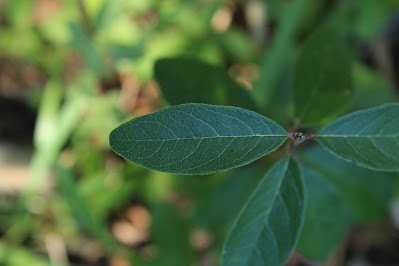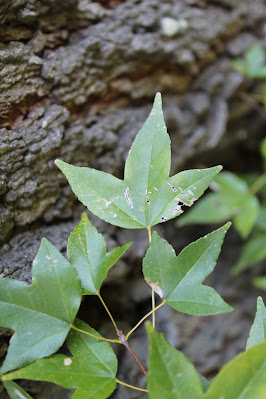 |
As we continue to clean up the volunteer recruitment area and make it more accessible, we also document the species that have taken root in this green space. Since the volunteers are by necessity an unmanaged population, this is an interesting sample of what survives the struggle for existence.
|
 |
| This week we are clearing a path around a looming specimen: our only large, on-site native southern red oak (Quercus falcata). It is the large trunk pictured center. Most of its upper branches are out of the frame. |
|
|
|
|
|
|
| |  | | Seen from another vantage, the same mature southern red oak (Quercus falcata), and the red bricks of the Student Union Building are seen in the background. |
|
 |
Over the past few years, we
haven't had a path around the base of this trunk.
|
 |
| Until today, the tree sign was hidden by the undergrowth. The area is
thick with vegetation. Numerous volunteers are present with several
different species represented. |
 |
Now, things have changed. First, the area was carefully surveyed for possible recruitments to the arboretum catalogue. This process involved weeding by hand―pulling up dewberry and snipping little trees. A few individuals, currrently very short in stature, were identified as candidates (we will let them grow up a little more before making it official). Then, this area was cut with a lawnmower to make a clear path.
|
 |
| Now, you can clearly see the sign. |
Most of the volunteers around the southern red oak were removed or cut back to the ground. Only a few were left unharmed, and they are not visible in this photo.
The photos below showcase the most
conspicuous volunteers that were removed. These individuals were quick to colonize a new territory and were winning in the competition for survival. Unfortunately, they didn't germinate in a space deemed suitable by the arboretum curator.
 |
chittamwood (Bumelia lanuginosa) REMOVED.... Although another chittamwood nearby will most likely be added to the arboretum's collection; it is located further away from the red oak's trunk.
|
 |
| oak (Quercus sp.) REMOVED |
 |
| trident-leaf maple (Acer buergerianum) REMOVED |
 |
| goldenrod (Solidago sp.) REMOVED |
 |
| trumpet creeper (Campsis radicans) REMOVED |
 |
| elm (Ulmus sp.) REMOVED |
 |
| redbud (Cercis canadensis) REMOVED |
 |
| nandina (Nandina domestica) REMOVED |
 |
| non-native holly (Ilex sp.) REMOVED |
 |
| red mulberry (Morus rubra) REMOVED |
 |
| Mexican plum (Prunus mexicana) REMOVED |
 |
| non-native privet REMOVED |
 |
| Virginia creeper (Parthenocissus quinquefolia) REMOVED |
 |
dewberry (Rubus trivalis) REMOVED This species was heavily represented around the base of the red oak trunk; the ground was thick with dewberry. This species is very successful in the ground of the arboretum.
|




















